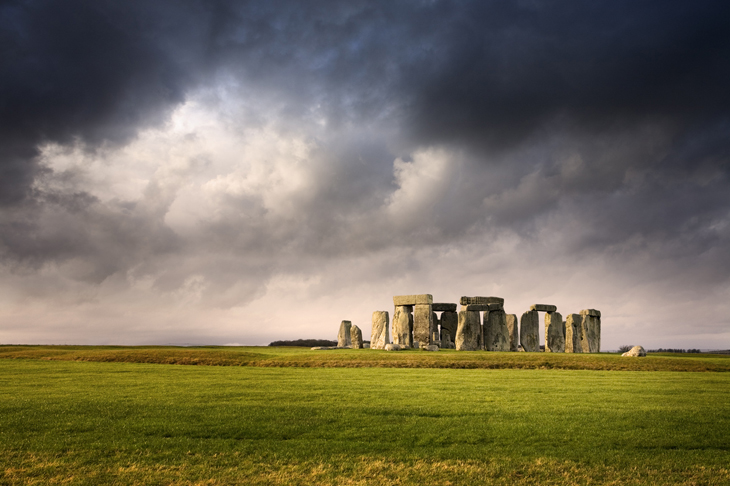The astonishing has happened at Stonehenge. Some prehistoric force has driven ministers to make a decision. It is to spend half a billion pounds burying the adjacent A303 in a tunnel, to bring ‘tranquillity’ to the ancient place. The result has been a predictable outcry from protestors. The television historian Dan Snow has compared the Transport Secretary, Chris Grayling, with Isis in Palmyra: ‘vandals and zealots who destroy ancient artefacts’. Stonehenge drives men mad.
The stones have for a quarter of a century been as impregnable to change as they have always been to interpretation. Whitehall has been unable to decide what to do with a single-carriageway road which runs 200 metres from the stones and causes hour-long traffic jams in summer. The two-mile tunnel is supposedly a compromise, between local activists who want a five-kilometre tunnel and those who just want improvements to the existing road.
In her recent history of Stonehenge, Rosemary Hill makes the point that ‘each century rebuilds the stones in its own image, by turns romantic, scientific, counter-cultural’. Such ancestral relics rightly enjoy peculiar protection. But the idea of Stonehenge as tranquil is novel. Tranquillity would never have been its essence. The stones have fallen, risen, been ignored, propped up with cement and hijacked by every loony in the land.
Their present image owes much to the cults for which they have become a magnet, the druids, wicker men, warlocks, ley lines, UFO-watchers and hippies who periodically, often entertainingly, incorporate them into their fantasies. The druid ‘King Arthur’ Pendragon is currently demanding free parking for his motorbike, citing some prehistoric European convention on human rights against having to ‘pay to pray’.
With 1.3 million visitors a year, the stones have become English Heritage’s most successful and lucrative attraction. When I was last there, the henge was packed with people and transport vehicles, far more intrusive than the A303. Those seeking tranquillity should visit neighbouring Avebury, to me a far better evocation of prehistory.
Stonehenge is not like France’s Lascaux Caves, so fragile they have had to be closed in favour of a facsimile. What you see is what you get, robust stones requiring little upkeep. Indeed their thrill is as much the view from afar as from close to, and is enjoyed by millions who drive past on their way to the West Country. It is the thrill of a glimpse, a passing reminder of the longevity of human habitation in this land. I love this view, as I do the distant sight of Lindisfarne or Arundel or Dover. Motorists are as entitled as paying visitors to delight in the English landscape.
In other words, Stonehenge presents a direct conflict between the ‘bought rights’ of visitors to the stones, and the freedom of members of the wider public to see them from afar. The motorist may detract from the paying visitor’s pleasure, but a tunnel would kill the motorist’s pleasure stone dead.
The real Stonehenge cult is that of the modern ruin. Our experience of these places is straitjacketed into a timed, ordered and ‘curated’ experience, by professionals with ingrained views. English Heritage’s vision of Stonehenge is of a disordered jumble of stones set in a lawn within a serene park. Fair enough, but for millions of people the distant view from the road is no less valid. I find it extraordinary to spend, at the last count, £540 million marginally to improve the Stonehenge environs for one group of beneficiaries.
The A303 bottleneck could be cured by leaving the existing road one way westbound, and finding an alternative pathway to the south for an eastbound route. The landscape would look much as it does now but without the jams. Motorists would continue to get an uplifting glimpse of their past. The Wiltshire hillside would be scarred but it would not be torn open. Millions of pounds would be saved.
Interpreting Stonehenge will always be a moveable feast, a table at which each age will dine after its own fashion. To spend half a billion pounds drastically to enhance the pleasure of a few at the expense of the many must be wrong.
Got something to add? Join the discussion and comment below.
Get 10 issues for just $10
Subscribe to The Spectator Australia today for the next 10 magazine issues, plus full online access, for just $10.
You might disagree with half of it, but you’ll enjoy reading all of it. Try your first month for free, then just $2 a week for the remainder of your first year.














Comments
Don't miss out
Join the conversation with other Spectator Australia readers. Subscribe to leave a comment.
SUBSCRIBEAlready a subscriber? Log in